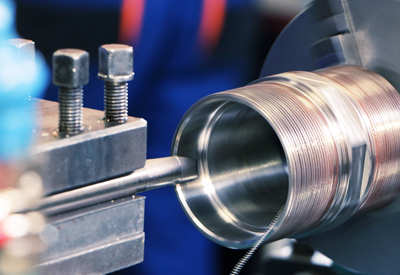Prevent Pollution in Your Pretreatment Process
 The pretreatment process can result in significant amounts of waste including solvents, water, and other chemicals. By implementing some pollution prevention opportunities, your facility can reduce the amount of waste generated and save money. Additionally, some of the solvents used in the pretreatment process can be hazardous; reducing their use can lessen the risk for employee exposure.
The pretreatment process can result in significant amounts of waste including solvents, water, and other chemicals. By implementing some pollution prevention opportunities, your facility can reduce the amount of waste generated and save money. Additionally, some of the solvents used in the pretreatment process can be hazardous; reducing their use can lessen the risk for employee exposure.
Assess Part Cleanliness
The first step for reducing pretreatment waste is to assess how clean your parts are prior to the pretreatment process. Determine the sources of contaminates and consider to what degree surfaces become contaminated with substances such as oil from machining, dirt from the manufacturing environment, and oil from people’s skin. Next, you’ll want to determine how much cleaning must be done to the parts prior to the pretreatment process.
Eliminate Contaminants & Change Cleaning Processes
Once contaminant sources are identified and cleanliness standards are set, determine which contaminants can be eliminated. Then, if contaminants cannot be reduced enough through process changes, assess the cleaning methods used to reduce the chemicals and water used.
Aqueous cleaning, which uses water-based chemistries, can be an alternative to chlorinated solvents. Aqueous cleaners eliminate the slight fire risk of petroleum solvents like mineral spirits and can provide a better work environment by reducing the volatile organic compound (VOC) emissions and their associated odors. This type of cleaner is also less likely to cause skin problems such as dermatitis. Aqueous parts washers, if chosen carefully and operated sensibly, can improve parts cleaning in your maintenance operation and may reduce hazardous waste generated. The following resources may help you learn more about aqueous parts washers and aqueous cleaning alternatives.
- MnTAP Fact Sheet: Aqueous Parts Washers for Small Operations (2009).
- MnTAP Intern Summary: Aqueous Alternatives for Cleaning Measurement Instrumentation (1993).
- MnTAP Resource List: Aqueous Cleaning Equipment Manufacturers (2004).
- MnTAP Fact Sheet Series: Get It Plated Right.
Reduce Solvent Use and Vapor Degreasing Operations
Solvents often used in the cleaning process prior to pretreatment can be costly and an environmental concern. Traditional solvents, like trichloroethylene, methylene chloride, and perchloroethylene, are expensive to use due to regulations. Newer solvents can be expensive to purchase.
It’s also important to note that a National Emissions Standard for Hazardous Air Pollutants (NESHAP) limits emissions from degreasers using traditional solvents. Toxic exposure to workers is another concern. Additionally, large uses of traditional solvents, over 10,000 lbs a year, require reporting under the Superfund Amendments and Reauthorization Act (SARA)/Toxic Release Inventory (TRI) regulations and pollution prevention planning under the Minnesota Toxic Pollution Prevention Act (TPPA). Therefore, solvents and vapor degreasing should be limited or eliminated if possible. The following resources may help you make that change in your facility. Additional resources are available on the Resources & Associations page.
- MnTAP Reference List: Alternative Solvent Degreasers (2008). This list provides information about degreasing and cleaning solvents that are alternatives to halogenated solvents.
- Online database: CleanerSolutions Database. The Massachusetts Toxics Use Reduction Institute developed this tool for solvent substitution in surface cleaning.
- MnTAP Intern Summary: Marathon Ashland Petroleum to Save $39,000 through Cleaning Changes (1998). The company eliminated almost all chlorinated aerosol spray use, purchased parts washers with fine filtration to replace four rental washers, and found alternatives to a terpene-based, large surface spray cleaner.
- MnTAP Case Study: Metal Stamping Company Saves $26,000 by Eliminating Vapor Degreasing (2007). Dayton Rogers Manufacturing Company used a strategic deburring process to replace trichlorethane vapor degreasing.
- MnTAP Case Study: Petroleum Solvents and Production Changes Replace Chlorinated Cleaning Solvents (2007). To eliminate 1,1,1-trichloroethane and CFC-113, Windings, Inc. took steps to eliminated 1,1,1-trichloroethane and CFC-113. The process changes the company made apply to other chlorinated solvents like trichloroethylene (TCE), methylene chloride and perchloroethylene (perc).
- MnTAP Fact Sheet: Reducing Solvent Emissions from Vapor Degreasers (2011). Strategies for reducing solvent emissions include drag-out, drafts, diffusion, and sprays.